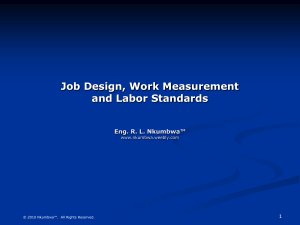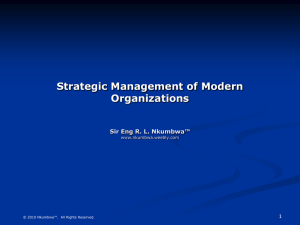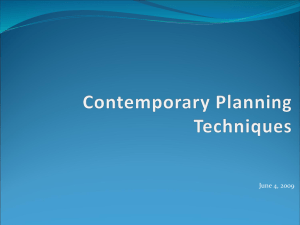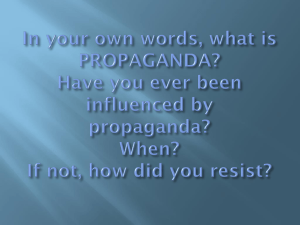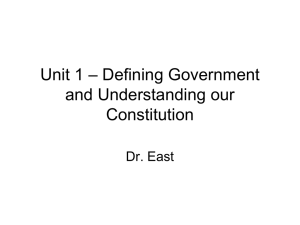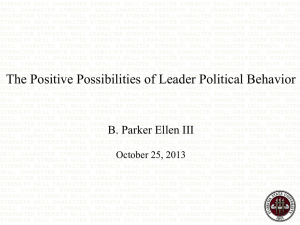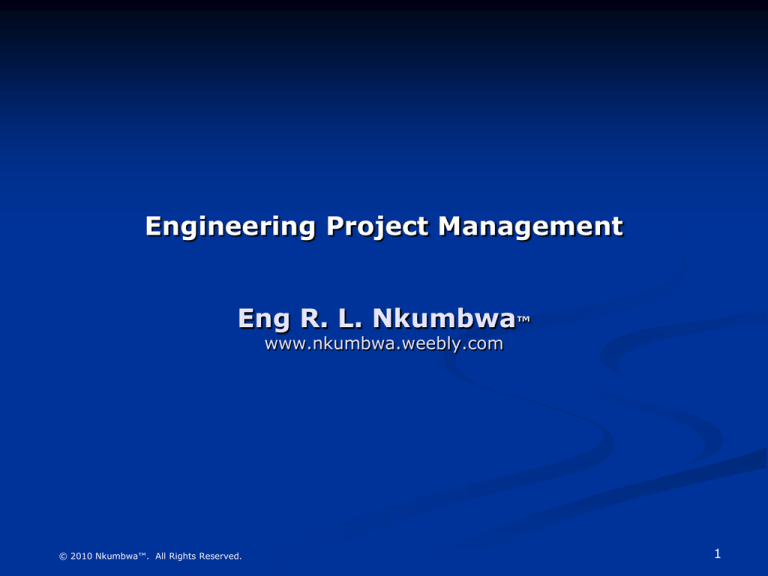
Engineering Project Management
Eng R. L. Nkumbwa™
www.nkumbwa.weebly.com
© 2010 Nkumbwa™. All Rights Reserved.
1
Outline
PM in today’s environment
rapid change
BPR
The project plan
Management & communications
Organizational, people, political issues
Stakeholders
Tools & methodologies
© 2010 Nkumbwa™. All Rights Reserved.
2
New Business Environment
Change – at ever faster pace
Globalization/Internet
Intense Competition
BPR leading to
Downsizing, flattening
Team approach, empowerment
E-Commerce, outsourcing
© 2010 Nkumbwa™. All Rights Reserved.
3
Change
Business Change
Projects
Project Management (PM)
© 2010 Nkumbwa™. All Rights Reserved.
4
Project Characteristics
Defined goal
Primary sponsor or customer
Set of activities
Unique, complex, sequenced
Start & finish
Temporary, time frame for completion
Limited resources
Dollars, people
Uncertainty, risk
© 2010 Nkumbwa™. All Rights Reserved.
5
Ongoing Activities
Have opposite characteristics to projects
Similar, often identical products or services
No defined end
Staffing & management practices geared to above
© 2010 Nkumbwa™. All Rights Reserved.
6
What is Project Management?
PM is the application of knowledge, skills, tools and
techniques to project activities in order to meet project
requirements. (PMI)
PM
is an art.
is a science.
has a set of tools and methods.
© 2010 Nkumbwa™. All Rights Reserved.
7
Three Disciplines
© 2010 Nkumbwa™. All Rights Reserved.
8
Project Dynamics:
The Triple Constraints
Cost
Time
Scope
Quality
Resources
© 2010 Nkumbwa™. All Rights Reserved.
9
Scope Creep (Wysocki)
Scope creep
any change not in original plan
IT particularly prone to creep
major challenge for PMs
Hope creep
will catch up next week
Effort creep
95-99% complete
Feature creep
team member adds features
© 2010 Nkumbwa™. All Rights Reserved.
10
Traditional Project Management
PM practiced (not by name) for millennia
PERT/CPM tools developed in 1950s
Focus on time, budget, specs
Gantt charts, Pert/CPM
s-shaped budget curves
resource matrices
Customers an afterthought
Project managers’ domain limited
implementers
© 2010 Nkumbwa™. All Rights Reserved.
11
New Project Management
Need to enhance traditional PM to:
become more customer focused
utilize new tools & softer skills
empower/select project managers
decision making
profit-loss responsibilities
entrepreneurial approach
business know-how
© 2010 Nkumbwa™. All Rights Reserved.
12
PMI PMBOK
Project management Body of Knowledge
© 2010 Nkumbwa™. All Rights Reserved.
13
Effective Project Managers
Lead by example
Visionaries
Technically competent
Decisive
Good communicators
© 2010 Nkumbwa™. All Rights Reserved.
Good motivators
Stand up to execs when
necessary
Support team members
Encourage new ideas
Zimmerman & Yasin 1998
14
Effective Project Managers
Alternate View
Leaders (also managers, administrators)
Communicators
Goal oriented
Problem solvers
Innovators
Work well under pressure (able to laugh)
Technically competent, respected, aware
Know company & its business
© 2010 Nkumbwa™. All Rights Reserved.
15
Project Manager Traits
Systems approach
Analytical skills
Ability to zoom
forest versus trees
big picture versus details
Firm yet flexible
“Velvet covered brick”
© 2010 Nkumbwa™. All Rights Reserved.
16
Project Life Cycle -- Phases
© 2010 Nkumbwa™. All Rights Reserved.
17
Project Management Process Groups
© 2010 Nkumbwa™. All Rights Reserved.
18
Project Life Cycle (Frame)
Concept
Planning
Execution
Closeout
Operation
Maintenance
© 2010 Nkumbwa™. All Rights Reserved.
19
PM Life Cycle (Wysocki)
Five Phases
1.
Scope project
2.
Develop project plan
3.
Launch plan
4.
Monitor/control project project
5.
Close out project
© 2010 Nkumbwa™. All Rights Reserved.
20
Why Projects Succeed
User involvement
Exec management support
unequivocal sponsorship
Clear understanding & statement
of requirements
Effective planning
Realistic expectations
Standish Group survey of IT execs
© 2010 Nkumbwa™. All Rights Reserved.
21
Building Bridges versus Software
Why do bridge projects usually succeed?
Why do software projects usually fail?
on time
within budget
meet expectations
© 2010 Nkumbwa™. All Rights Reserved.
22
Successful Projects
Depends on your point of view
Execs, users & project team view success differently
Is project successful if meets stated goals, schedule &
budget?
Does project result in tangible, cost effective business
improvement for users?
© 2010 Nkumbwa™. All Rights Reserved.
23
Success as perceived by Execs
Real business asset
Cost controlled (low)
Objectives achieved
Not oversold
Not over-committed
Well managed
effective controls, milestones achieved
© 2010 Nkumbwa™. All Rights Reserved.
24
Success as perceived by Project Team
Execs & users happy with results
Management committed & supportive
Necessary resources available
enough, adequate
Managed changes effectively
Schedule realistic
Gained experience
© 2010 Nkumbwa™. All Rights Reserved.
25
Project Discipline
Definition: act of encouraging desired pattern of behavior
the glue that holds it all together
project manager, team, organization
Implementing discipline
set realistic goals
obtain commitments
track progress against plans
enforce commitments
Whitten
© 2010 Nkumbwa™. All Rights Reserved.
26
Key Concepts (Verzuh)
PM – emerging career track
PM – art informed by science
Challenges of PM
personnel, estimating, budgeting, authority, controls,
communication
PM is industry independent, project managers aren’t
© 2010 Nkumbwa™. All Rights Reserved.
27
Key Concepts (Verzuh)
Continued
Managing Expectations (later session)
No damage
can’t keep giving 120%
order ulcer medication
Surviving organizational structure
authority, communications, priority, focus, chain of
command
© 2010 Nkumbwa™. All Rights Reserved.
28
Quotes from Verzuh
Primary responsibility of project manager to lead
customers, management, vendors and encourage them
to work together during the project.
Success may demand every technique in this book
Project manager is catalyst
Energy & attitude give the power
© 2010 Nkumbwa™. All Rights Reserved.
29
Silver Bullets
Organizations & their execs have problems
They look to projects to solve them
Too many have silver bullet expectations of projects
They fail to address the root causes of their problems
© 2010 Nkumbwa™. All Rights Reserved.
30
Success or Failure?
“BIG I”
Successful?
Well planned?
Clear accountability?
Did things go wrong?
Effective communications?
Carrot & stick?
© 2010 Nkumbwa™. All Rights Reserved.
“BCMDC”
Fiasco?
Planned or happened?
Anyone accountable?
Anyone fired?
Frank’s plumbing?
One disaster after another?
Who cares?
31
Overview
Delighting customers
Needs to requirements
Organizational issues
Stakeholders
Politics (revisited)
Getting the project off the ground
Scope the Project
Project Charter (Verzuh)
Project Overview Statement (Wysocki)
© 2010 Nkumbwa™. All Rights Reserved.
32
Delighting Customers
Delight – not just satisfy
Knowing who they are, what they want, when they are right &
wrong
Obsession with customer satisfaction is part of the new project
management
Nothing obvious/trivial about identifying customers
© 2010 Nkumbwa™. All Rights Reserved.
33
Delighting Customers (cont.)
“High-value organizations are in business of selling
solutions, not hardware, and customer
satisfaction achieved through partnering between
buyers & sellers”
(Frame)
© 2010 Nkumbwa™. All Rights Reserved.
34
Meeting Customer Expectations
Product/service usable
Promises kept
competent/gracious service
needs understood & addressed effectively
© 2010 Nkumbwa™. All Rights Reserved.
35
Customers= Needs/Requirements
Must work tirelessly to understand them
It’s a translation process twixt ill-defined languages
© 2010 Nkumbwa™. All Rights Reserved.
36
Customers= Needs/Requirements
Needs analyst traits:
strong ability to deal with customers
political skills
technically competent
open-minded & imaginative
high tolerance for ambiguity
articulate
Technicians tend to produce Mercedes not the Hyundai that=s
wanted
© 2010 Nkumbwa™. All Rights Reserved.
37
Bridging Customer-Developer Gap
Partner with customers (stakeholders)
Use “Joint” techniques:
Joint Project Planning (JPP)
Joint Application Development (JAD)
If fail to get needs/requirements right both sides at fault
Communications barriers
cultural, vocabulary, medium, feedback
Tips: be up front, cautious (Murphy’s Law), realistic, clear,
don’t jump to solutions, communicate/educate
© 2010 Nkumbwa™. All Rights Reserved.
38
Improving Needs Definition
Understand present system in full context
Identify multiple customers, prioritize their needs
Needs defining task force involving customers
Educate customers in rudiments of project management
must realize it=s an exercise in compromise
multiple customers, conflicting needs, budget & schedule
constraints
© 2010 Nkumbwa™. All Rights Reserved.
39
Needs Analysis
Organizational
Key
Areas of
Analysis
Present
System
© 2010 Nkumbwa™. All Rights Reserved.
Functional
Requirements
40
Organizational Issues
You are PM not CEO/COO
Yet you need organization’s commitment, so:
focus org. culture on customer value (culture change!)
unbridled change so organize into short, achievable
deliverables
improve processes for customer delight
strengthen project staff capabilities, e.g. business & nontechnical skills
© 2010 Nkumbwa™. All Rights Reserved.
41
Changing Corporate Culture
BPR (project oriented) not TQM (process oriented), so:
Focus on value
Encourage upside-down thinking
Power sharing
Long term view
Total customer focus
© 2010 Nkumbwa™. All Rights Reserved.
42
Business Reengineering & Quality Management
Business Quality
Improvement
Definition
Target
Potential
Payback
Risk
What Changes?
Primary
Enablers
Business
Reengineering
Incrementally Improving
Existing Processes
Radically Redesigning
Business Systems
Any Process
Strategic Business
Processes
10%-50% Improvements
10-Fold Improvements
Low
High
Same Jobs - More Efficient
Big Job Cuts; New Jobs;
Major Job Redesign
IT and Work Simplification
IT and Organizational
Redesign
© 2010 Nkumbwa™. All Rights Reserved.
43
Organizational Commitment
Organization committed to PM:
organization has project management system defining
processes & practices
system disseminated to employees via education &
training
Management instills the discipline necessary to ensure
system followed
system is living document not collecting dust
© 2010 Nkumbwa™. All Rights Reserved.
44
Customers Dont Cooperate
Common complaint from PMs:
customers not behaving responsibly
“customer” not monolith
prime cause organizational politics
Educate customers, educate, educate
emphasize contractual obligations
meeting key milestones
establish steering committee
© 2010 Nkumbwa™. All Rights Reserved.
45
Stakeholder Concept
In projects stakeholders are the movers & shakers
Stakeholder roles
Customers/users
Sponsor(s)
Line (functional) management
Project manager
Project team
Anyone/everyone else with a stake
Verzuh
© 2010 Nkumbwa™. All Rights Reserved.
46
Stakeholders
First identify all stakeholders
Must delight not just customers, but also stakeholders
This is tough!
Customers, management, project team must all agree on project
goals
Project manager must coordinate, guide, lead this diverse group
through the project stages
© 2010 Nkumbwa™. All Rights Reserved.
47
Politics Revisited
“Politics is the art of influence”
DON’T accept things at face value, be insensitive to politics, be
hyper-political
Action guide
positive attitude to politics
develop base of authority
get a grasp of political environment
action plan
© 2010 Nkumbwa™. All Rights Reserved.
48
Politics Revisited
Building authority
formal (from position)
technical/expert authority
charisma
purse string (rewards)
bureaucracy
old boy network . . . etc.
Support of “power players”
© 2010 Nkumbwa™. All Rights Reserved.
49
Project Teams
Traditional teams
full time members
co-located
easy to develop esprit de corps
Today’s teams
part-timers
not assigned for duration
virtual environment
tough to build effective teams, demands ingenuity
© 2010 Nkumbwa™. All Rights Reserved.
50
Getting Project off the Ground
Remember project success demands
goals agreed by all stakeholders
control of scope
management support
PROJECT CHARTER
brief, high level document formally establishing project
understood & signed by all key stakeholders
© 2010 Nkumbwa™. All Rights Reserved.
51
Project Charter
Establishes rules of game
What project includes, what it doesn’t (boundaries)
Goals, constraints, success criteria
Negotiate
Formally agree
Note Statement of Work (SOW)
NOT usual usage of term
© 2010 Nkumbwa™. All Rights Reserved.
52
Establish
Initiate
Charter establishes project
Next must compete with other projects for scarce
resources
Prioritize – go or no go?
Go ahead
Begin Analysis Phase
needs
requirements
detailed SOW
© 2010 Nkumbwa™. All Rights Reserved.
53
Wysocki: Scope the Project
Wysocki’s equivalent of the Charter:
Project Overview Statement (POS)
About one page, but
attachments: risk & financial analyses
approval by project mgr & core team (?)
Joint Project Planning (JPP) session
Project Definition Statement (PDS)
next stage
considerably more detail
© 2010 Nkumbwa™. All Rights Reserved.
54
POS Components
1.
2.
Problem/opportunity
factual statement
accepted by organization
Goal (one goal)
gives purpose & direction
what will be done
defines final deliverable/outcome
SMART
specific, measurable, assignable, realistic, time frame
© 2010 Nkumbwa™. All Rights Reserved.
55
POS Components
3.
4.
Objectives
1.
outcome
2.
time frame
3.
measure
4.
action
Success criteria
•
why do we want to do project?
•
measurable business value
•
sells project to execs
© 2010 Nkumbwa™. All Rights Reserved.
56
POS Components
5.
Assumptions, risks, obstacles
•
what can go wrong?
•
alert management to factors that may
interfere/compromise
•
specific, brief
© 2010 Nkumbwa™. All Rights Reserved.
57
Politics
Politics:
control of outcomes via control of people.
Use political tools in conjunction with product-oriented tools
Use of political tools NOT inherently bad
Ignoring politics can result in unnecessary losing outcomes
© 2010 Nkumbwa™. All Rights Reserved.
58
Politics vs Product
Product
Ethics
product/service provided to customer
function-quality-service
Success if meets specs, on time,
under budget
© 2010 Nkumbwa™. All Rights Reserved.
Politics
perception of what we provided
perception-expectation
success defined by positive surprises
59
Perceptions & Expectations
Customers have preconceived perceptions & expectations
Perhaps unrealistic, in hope of solving major problems
These perceptions/expectations are reality to them
If discrepancy, surprise will occur
© 2010 Nkumbwa™. All Rights Reserved.
60
First Law of Politics
Rule #1: surprise will always happen
Rule #2: managing surprises is key to customer satisfaction
First Law
Perception – Expectation = Surprise
Perception: view of product/service actually observed
Expectation: view what should be able to do
© 2010 Nkumbwa™. All Rights Reserved.
61
Reality is a Myth
Imagined
Map
Truth
. . what you believe
. . . . subjective
© 2010 Nkumbwa™. All Rights Reserved.
Real
Territory
Fact
. . . . what is true
. . . objective reality
62
Second Law of Politics
Second Law:
Perception = Reality
Doesn’t matter what you do, only what people think you do
As many truths (realities) as there are people; no-one better than
any other
© 2010 Nkumbwa™. All Rights Reserved.
63
Third Law of Politics
There are trade-offs twixt wants and needs
Also gap twixt wants/needs can create negative surprise later
hence poor customer satisfaction
Third Law
Wants – Needs = Surprise
© 2010 Nkumbwa™. All Rights Reserved.
64
Fourth Law of Politics
Fourth Law
Perception
today
= Expectation
tomorrow
This is law of political momentum
More effort required as time goes on to create positive surprises
© 2010 Nkumbwa™. All Rights Reserved.
65
Political Definition of Success
Notes:
Success exists in minds of customers
Success varies over time
Our task is to control surprises
This takes precedence over product/services
© 2010 Nkumbwa™. All Rights Reserved.
66
Equation for Success
Success = Sum of surprises as perceived by all customers over time
i=n
Success = ( ∑ S i )
t
i=1
n = # of customers
t = time
© 2010 Nkumbwa™. All Rights Reserved.
67
Equation for Success II
i=n
Success = (∑ s i w i )
t
i=1
w = weight associated with each
customer
© 2010 Nkumbwa™. All Rights Reserved.
68
Political Credibility
Every person/organizational component has a stack of political
“chips”
There is “price” when we try to control an outcome
If we don’t have enough chips at the time we fail to control
So vital to maintain sufficient pile of chips
© 2010 Nkumbwa™. All Rights Reserved.
69
Political Credibility
Chips go away when
we spend in political process
we create negative surprises
& they evaporate over time
We gain chips when
we create positive surprises
we “join”
& via our business/technical abilities
© 2010 Nkumbwa™. All Rights Reserved.
70
Attaining Political Credibility
Establish mission
what products/services we provide
Identify customers
functional (direct)
political (indirect)
Survey customers
what expectations/perceptions exist?
criteria for measuring them?
triggers for them?
© 2010 Nkumbwa™. All Rights Reserved.
71
Attainment (continued)
Survey customers (cont.)
customer wants/needs?
contradictions twixt them?
wall erected?
Establish vehicles
“For each customer, what vehicle exists to control
expectations/perceptions in the criteria for that user?”
© 2010 Nkumbwa™. All Rights Reserved.
72
Leverage Techniques
Leverage
to be effective must apply political credibility at right
point
this is principle of leverage
target chips toward specific “owners” (we may be
credible with one person not another)
not enough to have chips, we must have them in right
place at right time
© 2010 Nkumbwa™. All Rights Reserved.
73
Leverage Techniques
Leverage principles
target chips to be where & when needed
Identify winners/losers; winners work for you; losers
against
Use someone else’s chips; get one of winners to attempt
control
© 2010 Nkumbwa™. All Rights Reserved.
74
Persuasion
Common mistake among technicians
assume sufficient evidence/logical argument will convince
people
that reason & logic rule the day
But best idea backed by credible evidence won’t fly unless those
controlling outcome agree to it
We must sway the decision/outcome
© 2010 Nkumbwa™. All Rights Reserved.
75
Persuasion Process
Define decision we want
List every major player who can affect decision
people, groups, organizations
i.e. the stakeholders
Assess
position of each player -- for or against
power of each player
priority each player places on outcome
© 2010 Nkumbwa™. All Rights Reserved.
76
Persuasion Process (cont.)
What can we do to cause the power, position,
priority of each player to change so the outcome
we want will occur?
© 2010 Nkumbwa™. All Rights Reserved.
77
Persuasion (cont.)
Person Power Position Priority Score
A
B
C
4
2
1
4
-5
0
1
5
2
16
-50
0
(assign value, 1-5, 5 high)
© 2010 Nkumbwa™. All Rights Reserved.
78
Summary
Technical Competence is Insufficient
Embrace Politics
© 2010 Nkumbwa™. All Rights Reserved.
79
Remember Verzuh’s
Five Essential Success Factors
Agreement on Goals
Plan clearly indicating what and who
Constant, effective Communication
Controlled Scope
Management support
© 2010 Nkumbwa™. All Rights Reserved.
80
Overview
Selecting Projects
Risk Management
Work Breakdown Structure
Realistic Estimating
Scheduling Methods
Gantt, CPM, PERT
Time Boxes & Critical Chain
© 2010 Nkumbwa™. All Rights Reserved.
81
Selecting Projects
In most organizations projects must
compete for priority, dollars, resources
Financial Models
detailed financial analysis
cost–benefit ratios
© 2010 Nkumbwa™. All Rights Reserved.
82
Selecting Projects (cont.)
Martin Buss “How to Select Projects”
Harvard Business Review 1983
Small project selection team
grids with criteria, high-medium-low
criteria generally financial, technical, enhancing core
competencies, organizational fit against costs
review proposals, then quick collective judgment
© 2010 Nkumbwa™. All Rights Reserved.
83
Buss’s Grid Approach
Grid A
Low
Medium
High
High
Medium
Financial Benefits
© 2010 Nkumbwa™. All Rights Reserved.
Low
84
Risk – Risk – Risk
Life is full of uncertainty, i.e. Risk
Projects are inherently & especially risk prone
Insurance companies are risk managers
Re projects: Murphy was an optimist
if it can go wrong, it will
As project managers:
We must apply systematic risk management techniques
throughout project
They are part of our toolkit (PMBOK)
© 2010 Nkumbwa™. All Rights Reserved.
85
Risk Management
Software Engineering Institute (SEI) perspective:
URLs
http://www.sei.cmu.edu/programs/sepm/risk/risk.mgmt.overview.html
http://www.sei.cmu.edu/programs/sepm/risk/principles.html
Risk management must be continuous thru life of project
Risk & opportunity go hand in hand
© 2010 Nkumbwa™. All Rights Reserved.
86
SEI on Risk
"Risk in itself is not bad; risk is essential to progress, and
failure is often a key part of learning. But we must learn to
balance the possible negative consequences of risk against
the potential benefits of its associated opportunity."
© 2010 Nkumbwa™. All Rights Reserved.
87
Sources of Project Risk
General sources
environmental (largely uncontrollable)
external, e.g. government regulations
internal, e.g. new division VP
technical
market
financial
people
© 2010 Nkumbwa™. All Rights Reserved.
88
Sources of Project Risk (cont.)
What goes wrong with projects in your environment?
Standish top five success factors
user involvement, management support, requirements
greed/understood, planning, realistic expectations
Verzuh top five
agreed goals, planning, communication, controlled scope,
management support
© 2010 Nkumbwa™. All Rights Reserved.
89
Verzuh on Risk Management
Selecting right project is business risk; managing uncertainty
is project risk
Identifying risks – involve stakeholders
Risk Profiles: questionnaire addressing expected project risk areas
Guidelines:
industry & organization specific
address both product & mgt risks
gauge magnitude of risk – high/medium/low
© 2010 Nkumbwa™. All Rights Reserved.
90
Verzuh (cont.)
Dealing with risk (make a decision)
Accept – understanding risks, consequences, probabilities,
react if happens
Avoid – change scope to avoid, accept “low risk– low
return”
Monitor – contingency plans ready, e.g. at DIA back-up
baggage handling
Transfer – contract, outsource, insure (but remember win—
win)
Mitigate – work hard to reduce risk
© 2010 Nkumbwa™. All Rights Reserved.
91
Top 10 Risk Item Tracking
Tool for maintaining awareness of risk throughout life of a
project
Establish periodic review of the 10 project risk items
List current/previous ranking, number of times the risk
appears on list over time, summary of progress made in
resolving each risk item
© 2010 Nkumbwa™. All Rights Reserved.
92
Top 10 Risk Item Tracking Example
Monthly Ranking
Risk Item
This
Last
Month
Month
Inadequate
planning
1
2
4
Working on revising the
entire project plan
Poor definition
of scope
2
3
3
Holding meetings with
project customer and
sponsor to clarify scope
Absence of
leadership
3
1
2
Just assigned a new
project manager to lead
the project after old one
quit
Poor cost
estimates
4
4
3
Revising cost estimates
Poor time
estimates
5
5
3
Revising schedule
estimates
© 2010 Nkumbwa™. All Rights Reserved.
Number
Risk Resolution
of Months Progress
93
Expert Judgment
Many organizations rely on intuitive feelings & past
experience of experts to help identify potential project risks
Experts categorize risks as high, medium, low with or
without more sophisticated techniques
© 2010 Nkumbwa™. All Rights Reserved.
94
Results of Effective Project
Risk Management
Unlike crisis management, good project risk management often
goes unnoticed
Well-run projects appear almost effortless, but a lot of work goes
into running a project well
Project managers should strive to make their jobs look easy to
reflect the results of well-run projects
Duck on water – smooth on top, but underneath paddling like hell
to keep afloat
© 2010 Nkumbwa™. All Rights Reserved.
95
Estimating
“Project best understood by breaking it down into its parts”
Work Breakdown Structure (WBS)
powerful tool for doing this (not just a task list)
defines the total scope of the project
fundamental to much of project planning & tracking
© 2010 Nkumbwa™. All Rights Reserved.
96
WBS
Start at top, progressively break work down (tree structure)
into work packages
Roll up the packages for bottom up estimating
Packages give clear work assignments
For chart form of a WBS see Verzuh page 103
For outline (list) form see Verzuh page 104
© 2010 Nkumbwa™. All Rights Reserved.
97
Realistic Estimating
Lots of reasons for poor estimates
inexperience, technical problems, changes optimists, lowballing, politics
Bottom-up cost estimating
rollup the WBS packages
Top-down or Parametric estimating
from experience to complex models
© 2010 Nkumbwa™. All Rights Reserved.
98
Realistic Estimating (cont.)
Which technique is better?
ideally use both
early on don’t have WBS so must use top-down
accuracy of top-down depends on availability/quality
of historical data
building complete WBS can be expensive
but guesses can be even more costly
© 2010 Nkumbwa™. All Rights Reserved.
99
Developing Project Schedule
Base documents
Project charter – start/end dates, budget
Scope statement & WBS -- what will be done
Activity definitions
develop more detailed WBS
plus supporting explanations to understand all work to
be done
© 2010 Nkumbwa™. All Rights Reserved.
100
Scheduling Tools & Methods
Gantt Charts
Critical Path Method (CPM)
Program Evaluation and Review Technique (PERT)
Time Boxes
Critical Chain (Theory of Constraints)
© 2010 Nkumbwa™. All Rights Reserved.
101
Activity Sequencing
Review activities; determine dependencies
Mandatory dependencies: inherent in the nature of the work;
hard logic
Discretionary: defined by the project team; soft logic
External: involve relationships between project and external
activities
Must determine dependencies to use critical path analysis
© 2010 Nkumbwa™. All Rights Reserved.
102
Gantt Charts
Created 1800
Standard format for displaying project schedules
activities, durations, start/end finish dates displayed in
calendar format
Advantages
enforces planning
easy to create & understand
preferred for summary/exec-level information
Bar chart: simplified version
© 2010 Nkumbwa™. All Rights Reserved.
103
Sample Project Gantt Chart
© 2010 Nkumbwa™. All Rights Reserved.
104
Sample Tracking Gantt Chart
white diamond: slipped milestone
© 2010 Nkumbwa™. All Rights Reserved.
two bars: planned and actual times
105
Critical Path Method (CPM)
Developed 1957
CPM diagram shows:
activities, durations, start/end dates & sequence in which
they must be completed
Critical path for project:
series of activities that determines earliest time by which
project can be completed
Critical path is longest path through network diagram
has least (zero) slack or float
© 2010 Nkumbwa™. All Rights Reserved.
106
CPM (cont.)
Critical path helps you make schedule trade-offs
Slack or float :
amount of time activity can be delayed without delaying
early start of dependent activities
© 2010 Nkumbwa™. All Rights Reserved.
107
Simple Example of Determining
Critical Path
consider following network diagram
assume all times in days
C=2
start
1
A=2
2
B=5
4
E=1
3
6
D=7
5
finish
F=2
a. How many paths are on this network diagram?
b. How long is each path?
c. Which is the critical path?
d. What is the shortest amount of time needed to
complete this project?
© 2010 Nkumbwa™. All Rights Reserved.
108
PERT
Developed 1959 for Polaris project
Similar to CPM but addresses uncertainties in task
durations
Uses probabilistic time estimates – optimistic, most likely,
pessimistic estimates of activity durations
Hence reduces Risks associated with estimating
© 2010 Nkumbwa™. All Rights Reserved.
109
PERT Formula and Example
PERT weighted average formula:
optimistic time + 4X most likely time + pessimistic time
6
Example:
PERT weighted average =
8 workdays + 4 X 10 workdays + 24 workdays
6
= 12 days
where 8 = optimistic time, 10 = most likely time, and 24 = pessimistic time
© 2010 Nkumbwa™. All Rights Reserved.
110
Selecting Scheduling Approach
Consider project size, risk and complexity
Gantt
senior management
smaller, less complex projects
CPM
medium size/complexity/risk
PERT
high risk projects
medium to high complexity
© 2010 Nkumbwa™. All Rights Reserved.
111
Time Box Scheduling
Deals with delivering in short time frames
Focuses on prioritization
Facilitator brings stakeholders together to agree on
priorities
It’s customer–developer partnering
win-win
Compromise on scope to achieve early delivery
© 2010 Nkumbwa™. All Rights Reserved.
112
Critical Chain Scheduling
Addresses challenge of meeting or beating project finish dates
Application of the Theory of Constraints (TOC)
Developed by Eliyahu Goldratt in his books The Goal & Critical Chain
Method of scheduling that takes limited resources into account
when creating project schedule & includes buffers to protect
completion date
Assumes resources do not multitask as it often delays task
completions & increases total durations
© 2010 Nkumbwa™. All Rights Reserved.
113
Critical Chain (cont.)
Simple view:
in critical situation, don’t try to strengthen all of the
links in the chain
focus on the weakest link
Some organizations view as best thing since sliced bread
But does it sound like common sense?
© 2010 Nkumbwa™. All Rights Reserved.
114
Break then Case Discussion
Risk Management case
Guest Diane Luther (Ventana Group)
© 2010 Nkumbwa™. All Rights Reserved.
115
Embracing & Managing Change
Change will happen
Are we prepared to deal with it?
blurred visions
rubber baselines
fluctuating priorities
All contribute to:
Scope creep
schedule slippages
cost overruns
customer dissatisfaction
© 2010 Nkumbwa™. All Rights Reserved.
116
Sources of Change
Changing players
Folks change their minds
Budget instability
Technology keeps changing
Changing competitive environment
The economy
© 2010 Nkumbwa™. All Rights Reserved.
117
Change Management Strategies
Develop pro-change mind-set
only 16 % Promethean
“If it ain=t broke, don=t fix it@
in revolutionary times, traditionalists crushed beneath
tidal wave of change
innovation often comes from outside
Learn how/when to Ago with the flow@
And when to resist change
© 2010 Nkumbwa™. All Rights Reserved.
118
Developing Pro-Change
Mindset
Through education & training
Upside-down thinking, in order to thrive in turbulent times
Think multiple customers & stakeholders, not just one
Use crises to change traditional attitudes & focus on new
ways of doing things
© 2010 Nkumbwa™. All Rights Reserved.
119
Configuration Management (CM)
Resist change via bureaucracy
Change control via CM
Rigorously screen changes
formal process for assessing merit
major or minor impact?
if major goes to Change Control Board (CCB)
document changes
update baseline
© 2010 Nkumbwa™. All Rights Reserved.
120
Written change
proposal
Change Control Process
Rework
proposal
CCB Review
Accepted for impact study
Rework
Rejected
stop
proposal deigned,
documented,
implementation
schedule
Rework
Rework
proposal
CCB reviews
Accepted in product
Rejected
stop
Proposal
implemented
© 2010 Nkumbwa™. All Rights Reserved.
121
Change Management (Harris)
*
Accept all written change proposals
Project team assesses impact
cost, staff, schedule
Change team* reviews
value, importance (politically weighted)
triage
add to scope, phase II, phase III
Key stakeholders, project manager
© 2010 Nkumbwa™. All Rights Reserved.
122
Project Communication
Failure to communicate effectively often greatest threat to project
success
Communication is oil that keeps project running smoothly
Stakeholders
who needs to know what, when (how often) & how?
constant, effective communication among everyone involved in
project
formal, informal, written, verbal
© 2010 Nkumbwa™. All Rights Reserved.
123
Communications (cont.)
Need formal communications plan
plus informal supplementation as required
Integrated with overall project plan
Conflict is endemic to project, need skills to manage
confrontation (aka problem solving mode)*
compromise
smoothing
forcing
withdrawal (least desirable in projects)
* project management is all about solving problems quickly &
effectively
© 2010 Nkumbwa™. All Rights Reserved.
124
Communications (cont.)
Make assignments crystal clear
Running meetings effectively is key skill
Individual status meetings
spend regular, quality time with each team member
Kick-off meeting (see Verzuh)
need clear, decisive start
© 2010 Nkumbwa™. All Rights Reserved.
125
Effective Meetings (Verzuh)
Five rules
agenda in advance
begin/end on time
pass on information
come to decision
stay on track
Draw people out
avoid long meetings (one hour if practical)
for each agenda item
everyone should come prepared
silence not necessarily consent
Record decisions & action assignments
keep on top of resulting action list
© 2010 Nkumbwa™. All Rights Reserved.
126
Project Progress
Monitoring, Tracking, Controlling, Managing
How does a project get to be six months late?
Control versus Risk
control – track progress, detect variances in plan, take
corrective action
Balance risk & control
© 2010 Nkumbwa™. All Rights Reserved.
127
Monitor & Control
Progress reports
current period, cumulative, exception, variance
Level of detail
activity manager – detailed, granular
project manager – all open activities
senior management – graphical, exception, milestones
use WBS charts
Graphical reports – Gantt, milestone charts
© 2010 Nkumbwa™. All Rights Reserved.
128
Problem Tracking & Management
Daily – project manager tracks progress against schedule &
problems
Successful problem management
identify before happen or at least at first symptoms
put recovery plans in place – don’t delay
Problem management process
identify & determine criticality (80-20)*
assign an owner
document recovery plan
Monitor progress, daily if critical
* prioritize
© 2010 Nkumbwa™. All Rights Reserved.
129
Measuring Work Performance
PM “jokes”
last 10% of project takes 50% of the work
projects stuck at 90% for months
Problem not sudden insurmountable obstacles – it’s inaccurate
measurement
Percentage of work completed too open to subjectivity
Cost & schedule are 2/3 of cost, schedule, quality equilibrium,
so we measure them
© 2010 Nkumbwa™. All Rights Reserved.
130
Integrated Cost & Schedule Control
Graphical approach
Compare actual against planned /projected costs ($)
Problems
but $ spent don’t indicate actual work completed
Accounting information often lags
Hence Earned Value approach
determine value of work completed
© 2010 Nkumbwa™. All Rights Reserved.
131
Earned Value Chart for Project
(After Five Months)
© 2010 Nkumbwa™. All Rights Reserved.
132
Earned Value Approach
Developed in 1960s for large defense projects; now used in smaller
projects
50-50 rule assumes task 50% complete when started, 100% when
completed
Compare earned value to planned costs
Collecting data
large projects employ cost account managers
for
smaller projects, use 50-50 rule, take advantage of
milestones, or can guess using experience
Limitations of earned value
availability of accurate, timely data
educational; need organizational understanding
© 2010 Nkumbwa™. All Rights Reserved.
133
Outsourcing
Control costs
Focus on core work
Expand resources
Underlying rationale economic
bigger no long better
replaced by lean and mean
focus on core activities
with outside resources to cover auxiliary
goods/services
© 2010 Nkumbwa™. All Rights Reserved.
134
Outsourcing (cont)
Outsourcing is part of project manager’s toolkit
contracting skills essential
motivating staff who don=t work directly for you
strongest motivator is opportunity for self growth
Outsource all or major part of project
“Don’t underestimate risks of outsourcing”
© 2010 Nkumbwa™. All Rights Reserved.
135
Outsourcing (cont)
Contracts
Fixed-price
contracts,
OK
for
routine
implementations, not for high risk development
Cost-plus contracts, contractor paid costs plus a fee
(profit), variations to reduce excessive expenditure
Cost-plus-fixed-fee,
fee independent of costs,
attractive to contractors in high risk projects
cost-plus-incentive-fee, carrot and stick, incentive to
keep down costs
cost-plus-award-fee, award pool & level of award by
committee
© 2010 Nkumbwa™. All Rights Reserved.
136
Contracting Process
Source selection, competitive bid, sole source, informal selection
RFP provides bidders with format for proposal
for
software projects usual to include comprehensive
Statement of Work (SOW)
RFP for major project can be project in & of itself
Evaluating bids
establish evaluation criteria, (cost only one factor)
best & final offer from short-listed bidders
© 2010 Nkumbwa™. All Rights Reserved.
137
Contracting Process (cont)
Contract negotiations
rights, penalties, payment schedule, fee structure, schedule of
deliveries
Post-award
monitoring, regular say monthly reviews, attention to cost &
schedules variances, milestones, need change control process
Acceptance & handover
customer determines if terms & conditions of contract met
differences rooted in interpretation
problems often due to parties not having resolved different
perspectives, others to dynamic nature of projects
© 2010 Nkumbwa™. All Rights Reserved.
138
Joint Project Planning (JJP)
Variety of joint planning processes
JPP (Wysocki chapter 11)
Structured session
facilitator essential
key stakeholder involved
Objective clear & simple
develop project plan; negotiated between requestors &
providers
© 2010 Nkumbwa™. All Rights Reserved.
139
PM Policies & Practices
Consistent policies & practices throughout organization
SEI:
consistent approach to managing project 75% cost
reduction over different practices for each project
consistent management practices essential
development practices can vary
© 2010 Nkumbwa™. All Rights Reserved.
140
PM Policies & Practices
One policy does not fit all projects
Different practices for different types of projects, e.g.
small, medium, large
small, internal, external
practices for above should become progressively
more rigorous
© 2010 Nkumbwa™. All Rights Reserved.
141
Project Support Office
Support is operative word
Develops, documents, promotes PM policies & practices
Admin support (paperwork)
Consulting, mentoring on planning etc.
Organizational PM awareness, training
Verzuh
© 2010 Nkumbwa™. All Rights Reserved.
142
Project Support Office (cont.)
Support unit to project managers
PM standards
Manage communications
Admin support
Provide training
Mentoring role
Facilitate deployment (of PM staff)
Wysocki
© 2010 Nkumbwa™. All Rights Reserved.
143
Organization Wide
Today many project-based enterprises
PM policies & practices not just for active project participants
Increase PM competencies throughout organization
management, employees, contractors
Spectrum of PM training
Everyone should comprehend fundamentals
© 2010 Nkumbwa™. All Rights Reserved.
144
Cultural Change
Process change relies cultural change
Not an easy task due to people issues
Takes years rather than months
Project support office staff should be evangelists
Boeing:
Experiment, learn from users what adds value & what
does not . . .
© 2010 Nkumbwa™. All Rights Reserved.
145
Project Closure
“Those who cannot remember the past are
condemned to repeat it.”
George Santayana
© 2010 Nkumbwa™. All Rights Reserved.
146
Project Closure
Too often avoidance rather than effective closure; recall
Six Phases of a Project
1) Enthusiasm
2) Disillusionment
3)
PANIC
4) Search for Guilty
5) Punishment of Innocent
6) Praise & Honors for Non-Participants
© 2010 Nkumbwa™. All Rights Reserved.
147
Effective Closure
Ensure all deliverables installed
including documentation
Stakeholder acceptance of deliverables
Post-implementation review/audit
Celebrate success
© 2010 Nkumbwa™. All Rights Reserved.
148
Document The Project
Project review & evaluation
Final Deliverable – evaluation document
Summary of project history
project successes
Failures/problems
Compare estimates to actual
reasons/observations on differences
What should we learn?
Do and not do next project
© 2010 Nkumbwa™. All Rights Reserved.
149
Post-Implementation Audit
Evaluate project’s achievements against plan
budget, deadlines, specifications, quality of
deliverables, client satisfaction
Six questions:
1.
Project goal achieved?
2.
On time, within budget & per specs?
3.
Client (stakeholder) satisfied?
4.
Business value realized?
5.
PM lessons learned?
6.
What worked, what didn’t?
© 2010 Nkumbwa™. All Rights Reserved.
150

